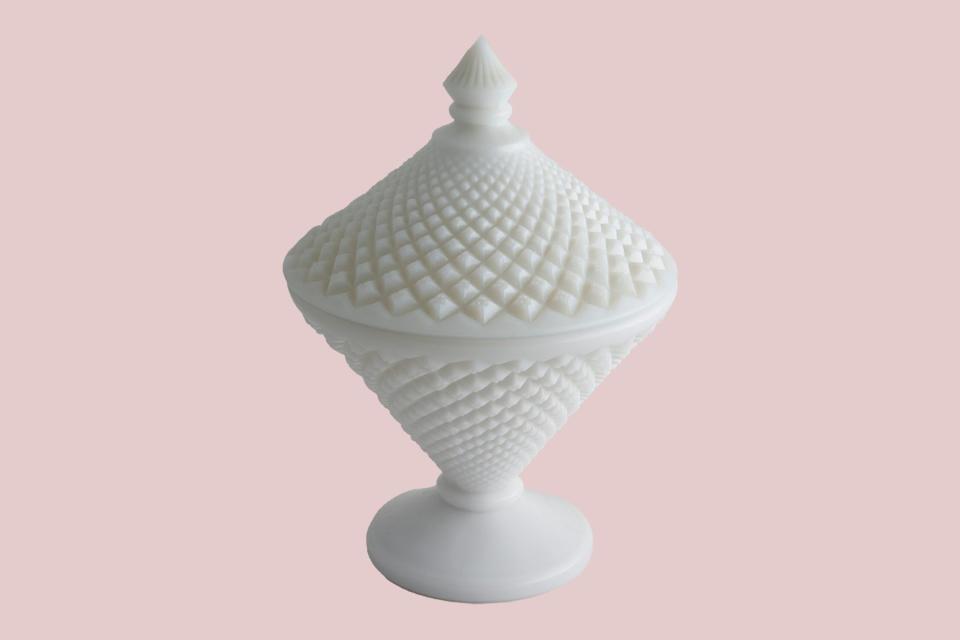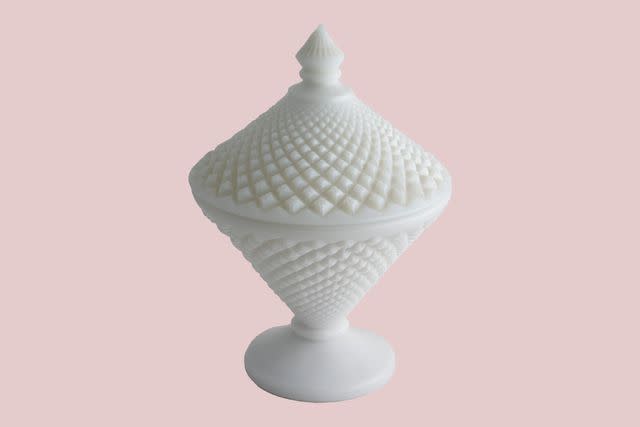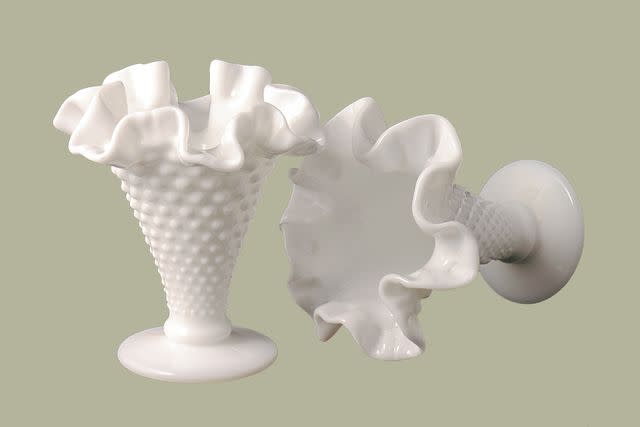A Guide to Collecting Milk Glass—and How Much It's Worth
Add these timeless, well-loved pieces, named for their opaque or translucent ivory hue, to your antique collection.

amattel / GETTY IMAGES
Antiques shops across America are lined with practical, vintage milk glass items in all shapes and sizes, items that your grandmother (and maybe even her grandmother) would have cherished: Tiny jewelry dishes for her nightstand, a milk glass reading lamp in the living room, or a tremendous white punch bowl that appears at every holiday gathering.
For generations, milk glass manufacturers made everything from hairpins to serving pieces in opaque white, blue, pink, and green shades. These vintage items, available at every price point, are easy to find and gorgeous to display, whether you're looking for a minimalist collection of petite vases or a complete set of everyday dinnerware.
Related:A Guide to Collecting Vintage Pyrex—Plus, How Much It's Worth

amattel / GETTY IMAGES
How Milk Glass Is Made
Creating opaque white glass is an ancient art, since similar vessels were made as early as 1500 B.C. in Egypt. But the term "milk glass" almost always refers to the white glass that was popular from 1835 through the 1980s in America and England. To create milk glass, early manufacturers added arsenic to their standard glass recipes, which yielded a faintly grayish, but nicely opalescent effect. Later, they used tinoxide, feldspar, and other additives to achieve a more saturated ivory hue.
In the early factories, molten glass was dropped into heavy iron molds. A worker then lowered a plunger to force the molten glass into every interstice and corner of the mold. The most significant contribution of the United States to glass production occurred in the 1820s, when machinery to press molten glass into metal molds was invented and perfected.
Popular Milk Glass Objects
Milk glass originally appealed to an expanding middle class, who aspired to the finer things in life. It was porcelain for the masses, an inexpensive substitute for luxurious tableware and accessories made by such companies as Wedgwood and Spode, whose designs milk glass manufacturers sometimes imitated shamelessly. Raised patterns of diamonds, rounded hobnails, and leaves and grapes became iconic elements of milk glass pieces.
Milk glass assumed many forms. The 1870s saw the rise of bowls and compotes. In the 1890s, fanciful dresser sets were the rage; one manufacturer, Fostoria Glass Company, created a set embossed with portraits of the actress Jenny Lind. Popular Victorian-era milk glass items included toothpick holders, smoke sets, covered hens, and mustard containers, says Christine Browning, president of the National Milk Glass Collectors Society. "During the 1950s, tableware was the most popular item made, but candles, vases and other pieces also were popular," she says. "There was not one particular object or specific genre made in milk glass; rather, pieces were made across the spectrum."
Milk Glass Collectibles That Are Popular Today
The most in-demand milk glass objects now include covered animal dishes, like the hen-on-nest style, floral trade vases, which were provided by florists with arrangements during the 1950s, '60s, and '70s, and pieces with the hobnail pattern, says Browning.
Where to Find Antique Milk Glass
Though milk glass was made consistently for decades, many collectors focus on one of two eras. "Milk glass popularity is divided basically into two camps: Those pieces that were made in the Victorian era, circa 1870 to 1910, and the resurgence in the 1950s," Browning says. "Today, collectors are most likely to find pieces made during the 1950s at flea markets and antique stores and online venues, such as Facebook."
Milk glass is still readily available for a simple reason, says auctioneer and appraiser Bene Raia. "There's a lot of it, because they made so much of it!" she says. She recommends thrift stores, estate sales, and yard sales ("There's always a box of milk glass at yard sales," she says) as a lucrative starting point for new collectors. For more specialty items, like older pieces or colored milk glass, Raia turns to eBay, Etsy, or to group antiques shops that include a glass specialist.

tmcnem / GETTY IMAGES
How to Determine the Value of Milk Glass
Because milk glass has been in production since the 1860s, collectors have a plethora of articles to choose from—many at very accessible price points. "Prices for milk glass, as well as all collectible glass, have seen a tremendous decline over the past 20 years," says Browning (which makes this an ideal time to start your collection without breaking your budget).
Availability
No specific milk glass items are more rare than others, says Browning, but older pieces are more often found in private collections than at flea markets or thrift stores. "Rarity is based not on a particular object, but on age, availability and condition," she says. "Although prices for rare items seem not to bring quite the same price that they did in the 1990s, a good piece of quality milk glass can bring several hundred dollars, with a truly rare piece heading into the thousands." (One example: A 12-inch-tall figure of a begging dog sold for $3,000 at the Society's 2022 convention.)
Color
Mid-century milk glass manufacturers put a modern twist on the traditional white color by producing items in pink, blue, green, and other opaque shades, plus swirled colors known as slag, says Browning. "These newer covered dishes in colorful colors made by Boyd, Degenhart, Summit, Mosser, and other companies during the 1970s are seeing a huge increase in popularity and are quite in demand these days," she says.
Raia agrees: "The colored ones are more rare and go for more money," she says. "You never see those at thrift stores."
Manufacturer
Determining the manufacturer of a piece of milk glass typically isn't easy. Few American manufacturers marked their glass. To top it off, glasshouses habitually caught on fire and shut down, and the molds were auctioned, scattered, and reused by other companies, making it maddeningly difficult to tell when, where, or by whom a piece was made. One of the largest producers in the 20th century was Westmoreland Glass Company of Grapeville, Pa.; its factory closed in 1985.
Only a handful of companies still manufacture milk glass, including the well-known Fenton Art Glass Company—a collector favorite—of Williamstown, W.Va. According to Browning, decorated milk glass made by certain companies—including Mt. Washington and C.F. Monroe—is often categorized as an "art glass piece," increasing its sale value.
How to Authenticate Milk Glass
Identifying milk glass is simple, says Browning: "It is opaque glass that cannot be seen through." However, connecting specific pieces to manufacturers or timeframes is much more difficult. "Typically, authenticity is confirmed by catalog, trade journals or sales information, but reproductions are rife in the industry," she says. "Education about what you are collecting is very important. Reference books area must, as well as handling glass and getting a feel for older glass versus newer."
New collectors can visit antiques shops or glass shows to touch as many types of pieces as possible. If you're looking for older pieces, says Raia, search for pieces with an especially smooth texture, which means they have been handled more.
Some older milk glass contains quantities of lead and will ring like a bell when tapped, says Frank Chiarenza, a collector, former president of the National Milk Glass Collectors Society, and the co-author of The Milk Glass Book, who was interviewed for Martha Stewart Living magazine before his death in 2018. "If you hold it up to the light, there are sometimes wonderful fiery colors around the edges, as if the glass were illuminated from the inside," he told us.
How to Care for Antique Milk Glass
Milk glass is remarkably sturdy, says Raia. Even smaller, thinner pieces hold up to daily use (and the occasional drop), often with only minor chips. Browning recommends washing unpainted milk glass by hand and keeping it away from large temperature changes. "Vintage milk glass is food safe, and was designed to be used on the table," says Browning.
Of course, you can also display your milk glass for purely decorative purposes: Raia has clients who have amassed large collections to contrast against an accent wall, while Chiarenza suggests keeping it in natural light. "I could see filling a bathroom window with shelves of milk glass, because light is what makes it magical," he says.

